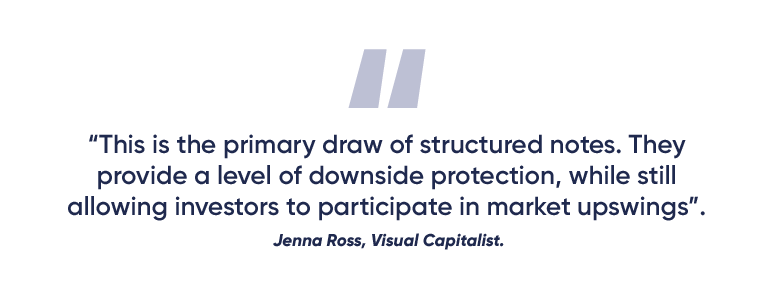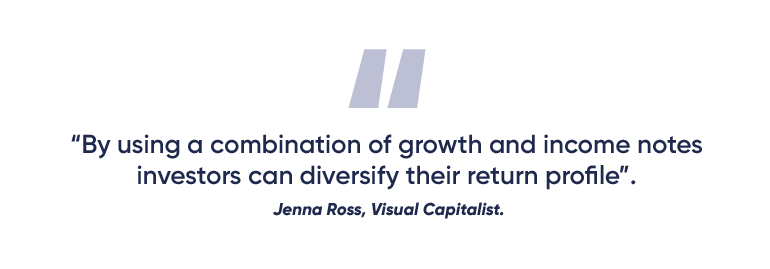
Understand the benefits of a structured note
Find out why structured notes should be a part of your investment portfolio
As structured notes are complex financial products, a simple definition of how it works is these investments are debt securities that are issued by financial institutions. The return on a structured note investment is linked to an underlying asset or group of assets. This underlying asset could comprise stocks, commodities, interest rates or currencies.1
The purpose of a structured note is to provide an investment payoff that is attractive to investors and that is differentiated from returns available in simple equity and fixed-income markets. Cashbox Global is one of Wealth Migrate’s deal sponsors that focuses on structured notes. In a co-hosted webinar with Wealth Migrate, we had Andrew Mobsby Head of Product and Chad Pope Head of Operations, join Scott Picken Chief Executive Officer to discuss investing in structured notes and how it works.2
In a 2020 webinar poll, Wealth Migrate and Cashbox Global asked how many investors were new to the concept of structured notes as an investment with an outcome of 67%, whereas only 29% knew of this investment product.3 This shows that most investors still do not understand the benefits of investing in structured notes and that is why Wealth Migrate’s next article series in partnership with Cashbox Global focuses on this investment class.

Understanding structured notes
Historically structured notes have been investment vehicles for the very wealthy with a minimum investment needed of at least $1 million (USD).4 As a fixed-term investment, these offer investors the benefits of national and international equity along with defined limits of risks and returns.
According to Visual Capitalist, “structured notes are hybrid securities that contain a bond component and an embedded derivative”.5 This is important as the value of financial security is derived from an underlying asset and as investments issued by banks offer a level of downside protection for investors.

There is a dynamic element to structured notes as each investment has its specific set of risks and rewards. Investors can opt to receive more capital protection and lower investment returns or less capital protection for a yield of higher returns (more growth participation).6 A structured note is a personalised product that can be created for any investment goal by using four main building blocks.
Here are the four building blocks that create the foundation of a structured note:

Underlying asset
1. The performance of a structured note tracks the price return of an underlying asset.7 This can be linked to stocks, a group of stocks, commodities or foreign currency over a certain maturity period.

2. Maturity
Referring to the time period over which structured notes are held, structured notes generally range in holding periods from three to five years.8

3. Level of protection
This works by offering the investor a level of protection against declines in the price of the underlying asset.9 To protect investors from more losses, the protection amount ensures that should the value of the underlying asset fall, it won’t go below the protection amount and that those investors should be paid back in full, the initial investment amount.

4. Return
The amount the investor receives over the holding term of the note if specific market conditions are met.10
Structured notes appeal to retail investors who cannot easily obtain access to these investment products. Therefore, the nature of structured notes offers flexibility on a scale that can tailor risk exposure to suit investors’ needs and the possibilities for what meets these needs are extensive.
Structured notes provide the means for banks to issue debt for themselves or other companies at lower options than market rates. Before the existence of structured notes, one of the only means to submit a submarket coupon was by issuing convertible bonds – also a hybrid security that pays interest but can be converted into stock.11 Convertible bonds allow banks to give investors something in exchange for a lower interest rate on debt.
Benefits of using structured note investments
These differ with the risk-to-reward ratio as mentioned and the type of structured note investment. This falls into two categories, growth or income notes. Growth notes give an investor an opportunity to receive a return at maturity, this payment depends on the performance of the underlying assets linked to the structured note.12 Income notes allow investors to receive fixed quarterly or annual coupon payments on pre-defined dates.13
Benefits from investing in a structured note vary from:14
- Reducing capital loss from market declines (downside protection)15
- Upside (or enhanced) participation
- Regular income from coupon payments if certain market conditions are met
- A return at maturity if certain market conditions are met

A hybrid investment asset
The hybrid nature of structure notes ensures that investors have more control over their portfolios with defined outcomes. Access to investing in structured notes has become more open and readily available, and this can be a valuable addition to any investor’s portfolio due to the many options to tailor it to specific investor needs.
The potential of receiving high returns as much as 10% to 14% with capital protection, even in flat or declining markets is one of the reasons why investors consider these types of investments. In terms of the wealth pyramid, structured notes fall under the wholesale cashflow asset allocation. These are assets that investors plan to keep for one to five years, with an aim for target returns of 15%-240%.
As part of an ongoing educational series, discover what Wealth Migrate and Cashbox Global’s perspectives are on structured notes. Explore the pros and cons of investing in this type of investment, with real examples from CashBox Global’s structured note offerings.
1 Reed, Eric. (May 2022) ‘What are structured notes and how do they work?’. Retrieved from SmartAsset.
2 Wealth Migrate. (February 2020). ‘Introducing CashBox Global and their structured note offering’. Retrieved from YouTube.
3 Wealth Migrate. (February 2020). ‘Introducing CashBox Global and their structured note offering’. Retrieved from YouTube.
4 Ross, J. (December 2019). ‘Structured notes: the secret to improving your risk/return profile?’. Retrieved from Visual Capitalist.
5 Ross, J. (December 2019). ‘Structured notes: the secret to improving your risk/return profile?’. Retrieved from Visual Capitalist.
6 Bredenkamp, B. (November 2021). ‘Have you considered investing in structured products?’. Retrieved from Moneyweb.
7 Ross, J. (December 2019). ‘Structured notes: the secret to improving your risk/return profile?’. Retrieved from Visual Capitalist.
8 CFI Team. (February 2021). ‘Structured note’. Retrieved from Corporate Financial Institute.
9 Bredenkamp, B. (November 2021). ‘Have you considered investing in structured products?’. Retrieved from Moneyweb.
10 CFI Team. (February 2021). ‘Structured note’. Retrieved from Corporate Financial Institute.
11 Rebecca Baldridge, R., and Curry, B. (May 2021). ’Convertible bonds give you the best of both stocks and bonds’. Retrieved from Forbes.
12 Mayer, E. (November 2020). ‘Why structured notes are one of the most innovative options to come out since the mutual fund’. Retrieved from Worth.
13 Mayer, E. (November 2020). ‘Why structured notes are one of the most innovative options to come out since the mutual fund’. Retrieved from Worth.
14 Shamim, K. (March 2021). ‘Beginner’s guide: what are structured notes and how they are used in portfolios?.’ Retrieved from Quadra Wealth.
15 Cook, T. (October 2017). ’Downside protection; what, why, who, how and when?’. Retrieved from Russell Investments.